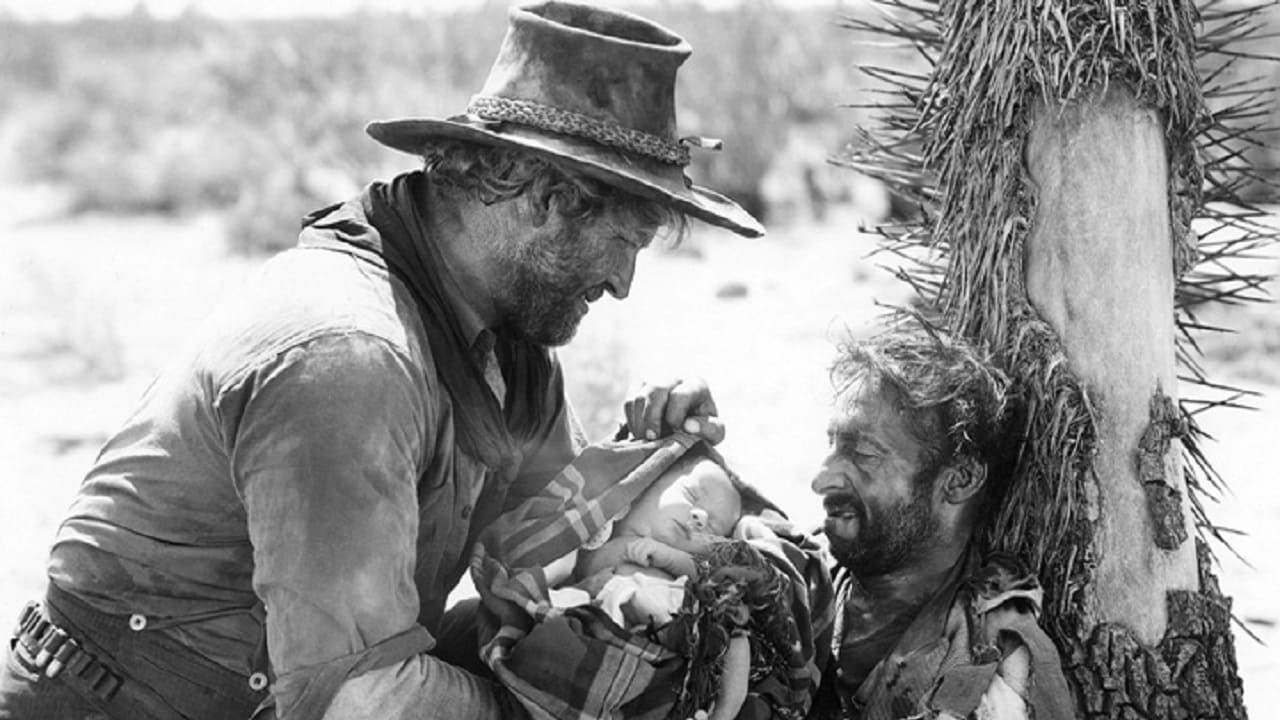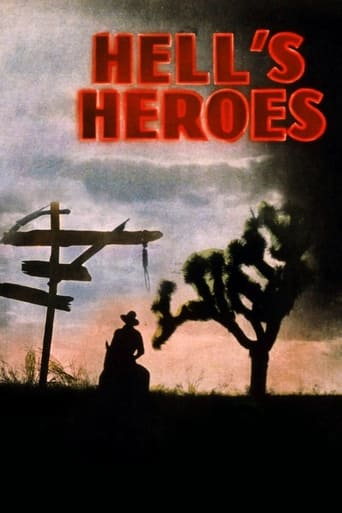

In the western town of New Jerusalem, rough Charles Bickford (as Robert "Bob" Sangster) cajoles his sexy girlfriend to sing and dance while he waits for the gang to arrive. The men rob the bank, killing a teller in the process, and escape from the sheriff's posse in a sandstorm. Left without horses and possessing only a small portion of water, Mr. Bickford and his two pals prepare to face the harsh elements. Sporting a shoulder wound, Raymond Hatton (as Thomas "Barbwire Tom" Gibbons) notes religious allegory. Self sacrificing Fred Kohler (as William "Wild Bill" Kearney) carries most of the baggage...The three men happen upon a woman moaning in a covered wagon. They appear to agree that the man who saw her first gets to be the first rapist. However, Bickford and company discover the woman is pregnant with the baby of the bank teller they killed. Before expiring, she dubs the bandits her "Three Godfathers" and asks them to take care of her baby son. "Hell's Heroes" is a crude version of the frequently-filmed Christian story. Bickford and director William Wyler combine to create some memorable images.****** Hell's Heroes (12/27/29) William Wyler ~ Charles Bickford, Raymond Hatton, Fred Kohler, Maria Alba
... View MoreHell's Heroes (1930)*** 1/2 (out of 4) This early talkie from Universal is the first sound version of "Three Godfathers", which would eventually be remade in 1936 with Chester Morris and again in 1948 by John Ford with John Wayne in this lead. The story here is the same as three ruthless outlaws (Charles Bickford, Raymond Hatton, Fred Kohler) rob a bank and then head out into the desert before losing their horses during a major wind storm. Soon afterwards they stumble onto a baby and the men must decide to let it die or try to walk it back to the town they were just running from. I've ended up watching these sound versions in reverse order as I started off with the Ford one many years ago and then just recently saw the Morris version, which was the better of the two. This one here is clearly the leader of the trio because of how raw it is. This movie is pretty mean spirited from the start up until the end and I really love that Wyler didn't pull any punches. Being the pre-code era we get a few things not available in future versions and that includes one sequence where the men argue about who's going to "take" the mother first. We also get a fairly violent scene involving a suicide, which is shown in a long shot. A lot of people bash American westerns saying they aren't ugly enough but that's not true here. The dirt, grease and ugliness of the characters are all over them and their unshaven faces make them look exactly like what their characters would look like. The three leads turn in wonderful performances but to me it was Hatton who steals the show as the big goon who quickly turns into a softy after finding the baby. Bickford is equally impressive and the final vision of him is quiet haunting and will certainly stay with you for a long time. The film runs a fairly short 68-minutes but there's enough heart and soul in this thing for two movies. Another impressive thing is that this was an early talkie yet you really can't tell as everything is recorded very well and it actually sounded a lot better than the same studio's Dracula and FRANKENSTEIN, which would follow the next year.
... View MoreMuch tighter and less bloated with extra characters and subplots than the later versions. The story has enough plot on it's own. It avoids the pitfall of being syrupy, a pitfall that the John Wayne version does not avoid. It's not the sanitized west of most films of the genre. You just know that those hombres hadn't bathed in a month of Sundays. The film gets right down to business. It avoids another pitfall, as well. Early talkies tended to be just that--talkie. This film makes good use of visuals in developing the characters and moving along the story. It has much more of the feeling of the just past silent era about it than the just arrived talkie era.
... View MoreThere is a production still photo (reprinted recently in Scott Eyeman's 'The Speed Of Sound') that has haunted me ever since I first came across it in 1968. It was in a humanities class text. We had studied von Stroheim's "Greed" and upturned the story of how. while shooting on location in the Mojave Desert, the cameras had to be iced against the heat while the crew's cook died from the solar furnace. And here, four years later in the Panamint Hills, is a black and white of a sound film crew out in the desert. A long black cable in the sand leading up to an airtight meat locker housing the camera and its operator. The sun blazing down, I wondered, what kind of a film could get done under these conditions? Further research heightened my frustration as William Wyler was listed as the director (must be a good film), but it was for Universal, already notorious for keeping their early talkies tightly vaulted.Flash forward 34 years (and a big Thank You Ted Turner and TCM). It is 2:30 AM and I can't sleep. In the next room, a VCR awaits its task of making sure I don't miss this. But I'm pacing the floor for an hour and a half, heart pounding with anticipation. "I can't be very good", I tell myself, "Bickford isn't Gable". Fade up, dozens of bat-wing parchments of nitrate flap before some lamp and credits roll, I'M FINALLY SEEING IT! The camera's lens prowls back and forth across barren landscape, as though it was looking for something. Three riders appear on horseback. The dialogue begins and it's good, the camera moves right along with the riders. The lighting is remarkable as the faces well-saturate the negative [something anyone who has attempted photography in bright sunlight will appreciate]. In town, this gang's leader is in the saloon making time with the ladies. Bickford establishes his character in this sequence as one who is harder and more heartless than anyone else in westerns. He'll tell the sheriff he's going to rob the bank (across the street). A high establishing shot shows the whole town, then a shot tracks with Bickford approaching the bank as his gang rides up. This is cinema, a montage of perceptions that completely fill the viewer's consciousness. This film is very, very good.George Robinson's photography is extraordinary, with fine compositions and contrasts. His vistas are jam packed and firmly place the viewer into this nothingness. The actors' beards progress with the time frame, and the place is so dirty you'll run for the Pledge.It's filled with those two second throwaways that tell so much about the characters but do nothing to advance the plot. Such as when the gang leans on the teller's counter, one cowboy's boot scuffs at the bottom for a bar rail. At the saloon, a short skirted woman dances for the patrons, a low angle shot gives a glimpse of garter. The sheriff, seated nearby, drops something and pretends to pick it up. He stares lecherously at the dancing knees. Yet, a moment later, when Bickford invites him to drink, the sheriff's back on his moral high horse. Bickford bites and slaps the girl, after all this is pre-code.The characters are complex and juxtaposed images abound. Charles Bickford's portrayal is unforgettable. Here is a picture that deserves recognition as one of the classics, a film that transcends its primitive equipment. Makes one wonder what else is locked up in the vaults of the Big U.
... View More